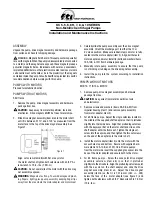
Page 34
EA Elektro-Automatik GmbH
Helmholtzstr. 31-37 • 41747 Viersen
Germany
Fon: +49 2162 / 3785-0
Fax: +49 2162 / 16230
www.elektroautomatik.de
EL 9000 B 15U/24U Series
3.
Operation and application
3.1
Personal safety
•
In order to guarantee safety when using the device, it’s essential that only persons operate
the device who are fully acquainted and trained in the required safety measures to be taken
when working with dangerous electrical voltages
•
For models which can generate a voltage which is dangerous by contact, or is connected to
such, the included DC terminal cover or an equivalent must always be used
•
Whenever the DC input is being re-configured, you must switch off or even better, disconnect
the source!
3.2
Operating modes
The device is internally controlled by different control or regulation circuits, which shall bring voltage, current and
power to the adjusted values and hold them constant, if possible. These circuits follow typical laws of control sys-
tems engineering, resulting in different operating modes. Every operating mode has its own characteristics which
are explained below in short form.
3.2.1
Voltage regulation / Constant voltage
Constant voltage operation (CV) or voltage regulation is a subordinate operating mode of electronic loads. In
normal operation, a voltage source is connected to the electronic load, which represents a certain input voltage. If
the set value for the voltage in constant voltage operation is higher than the actual voltage of the source, the value
can’t be reached. The load will then take no current from the source. If the voltage set value is lower than the input
voltage then the load will attempt to drain enough current from the source to achieve the desired voltage level. If
the resulting current exceeds the maximum possible or adjusted current value or the total power according to P
= U
IN
* I
IN
is reached, the load will automatically switch to constant current or constant power operation, whatever
comes first. Then the adjusted input voltage can no longer be achieved.
While the DC input is switched on and constant voltage mode is active, then the condition “CV mode active” will be
shown on the graphics display by the abbreviation
CV
, as well it will be passed as a signal to the analog interface
and stored as internal status which can be read via digital interface.
3.2.1.1
Speed of the voltage controller
The internal voltage controller can be switched between “Slow” and “Fast” (see
„3.4.3.1. Menu “General Settings”“
).
Factory default value is “Slow”. Which setting to select depends on the actual situation in which the device is going to
be operated, but primarily it depends of the type of voltage source. An active, regulated source such as a switching
mode power supply has its own voltage control circuit which works concurrently to the load’s circuit, but both could work
against each other and thus lead to oscillation. If this occurs it’s recommended to set the controller speed to “Slow”.
In other situations, e.g. operating the function generator and applying various functions to the load’s input voltage
and setting of small time increments, it might be necessary to set the voltage controller to “Fast” in order to achieve
the expected results.
3.2.1.2
Minimum voltage for maximum current
Due to technical reasons, all models in this series have
a minimum internal resistance that makes the unit to be
supplied with a minimum input voltage (U
MIN
) in order to
be able to draw the full current (I
MAX
). This minimum input
voltage varies from model to model and is listed in the
technical specifications. If less voltage than U
MIN
is sup
-
plied, the load proportionally draws less current, which
can be calculated easily.
See principle view to the right.
I(A)
U(V)
I
Umin
Imax
















































